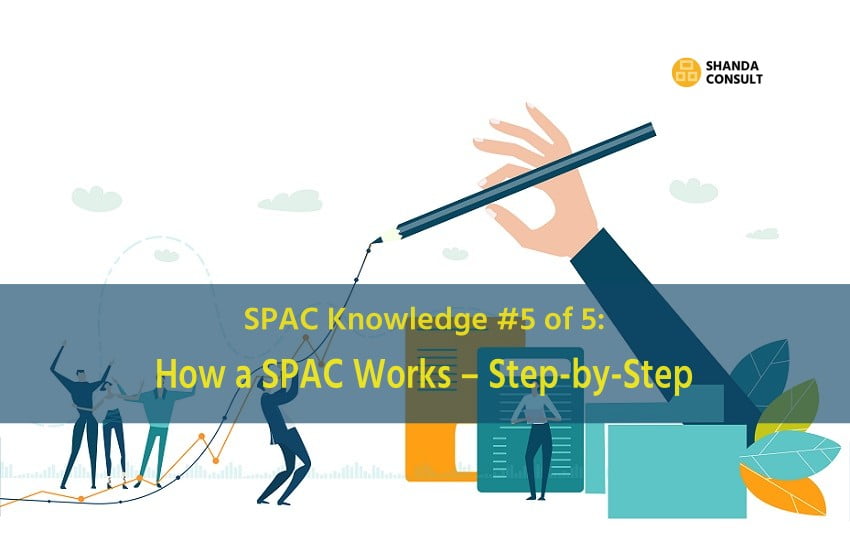SPACs - How does it work?
From the initial idea to sponsoring, structuring, public listing, IPO and acquisition
SPACs – A step-by-step guide from A to Z
SPACs Step-by-Step – from the Sponsor to IPO to Acquisitions
Please read more about SPACs and our SPAC services on our dedicated SPACs website.
A Special Purpose Acquisition Company (SPAC) is a public company that is created to acquire private assets. There are a number of ways to use a SPAC, but the process of creating, funding, and then buying private assets is basically the same, no matter the goals of the SPAC.
While the end result of a SPAC will be a publicly traded company that owns formerly private assets, the process that achieves this result takes place in a number of stages. If you want to know more about how a SPAC is formed, funded, and operates, you are in the right place.

Here are the basics of the SPAC process, as it applies once a SPAC business idea has been defined and the SPAC’s acquisition strategy has been outlined:
Step 1: One or more pre-IPO Sponsors will pay for the initial setup costs and commit the SPAC’s sponsor capital, which is 5.1% of the planned IPO proceeds. The costs to set up the SPAC and conduct the first roadshow (pre-IPO) will be around $800,000 USD, with 5.1% of the planned IPO proceeds as sponsor capital added to that amount. About two thirds of the setup costs need to be paid prior to the IPO, while the last third will be covered from the IPO proceeds. Setup costs paid will be refunded to the paying sponsor from the IPO proceeds.
Step 2: The SPAC will be incorporated as a company, typically as an LLC.
Step 3: The Company will apply to the Securities and Exchange Commission (SEC) in the USA for S1, also known as the prospectus. This will detail the SPAC’s shareholders, board members, its acquisition strategy and statutory information.
Step 4: The pre-IPO sponsors are now able to deposit the necessary funding into the SPAC’s trust account, typically held by a lawyer. In return for their pre-IPO investment, sponsors receive founder shares. Founder shares will be converted into listed common shares on the day of IPO, typically in a ration of 1:1.225 to 1:1.25.
Step 5: The S1 that was filed with the SEC gets approved, and the SPAC is now ready for listing at a stock exchange and for IPO, provided that the sponsor capital has been paid into the trust account.
Step 6: The investment bankers or other investors will organize roadshows to promote the SPAC. The goal of this is to attract large institutional investors to participate in the IPO of the SPAC. The CEO and CFO of the SPAC typically participate in these roadshows, together with a high-rank manager of the underwriting bank.
Step 7: As a result of the roadshows, institutional investors or similar, sophisticated investors are ready to commit capital to buy shares in the SPAC at its IPO.
Step 8: The SPAC will be listed on the NYSE or NASDAQ (or other stock exchanges; double listing is also possible) by the underwriting bank. It is now a publicly traded company.
Step 9: The morning after being listing on a public exchange the SPAC will have its IPO.
Step 10: Institutional investors will buy shares in the SPAC via the IPO process; their funds will be held on trust account. Shares will also trade on a public exchange, although until there is news flow, the trade volumes are likely to be muted. In general, the value of the shares will be USD $10, although this can be modified.
Shanda Consult also works to ensure that SPAC sponsors will get a full warrant for every US Dollar sponsor capital invested. Most SPAC IPOs will include a partial warrant with every share, but we work to get the most for investors.
Step 11: The board of the SPAC will begin to pursue possible acquisitions that are in line with the prospectus of the company. If another goal was a part of the prospectus, such as the acquisition of a specific company, the board will begin that process.
Step 12: The SPAC will acquire a private company or companies, or parts of them. These target companies must be private, and not listed on public exchanges.
Step 13: The target companies may be acquired as a mix of the following three ways. There are, of course, other options, but these three are common:
- Cash payments are made the sellers of the target company.
- Fresh shares in the SPAC are issued and exchanged for ownership of the target company.
- Asset-backed financing (a method of debt financing where banks can lend funds based on the collateral offered by the target company).
Step 14: After the target company or companies are acquired, it or they will be merged into the SPAC, which is a publicly listed company. This process is called a reverse merger, and it makes formerly private assets public. This final step is also referred to as “de-Spacing” or “business combination”. Once it is complete, the SPAC no longer exists, and it is a regular, publicly traded company.
Making the Most out of Great Assets
SPACs can create incredible returns for investors and help great private assets access funding in the public markets. At Shanda Consult, we know the SPAC process, have deep connections across the investment industry.
If you have a company that has developed an incredible product or new technology, we can help you take your development program to the next level. In a market where funding is becoming increasingly difficult to access, SPACs offer investors and innovators a way to keep going in the right direction.
Brief SPAC introduction of SPACs (new, Feb 2020)
“What is a SPAC? What are the advantages of SPACs? What do we do and why people prefer us!
You are welcome to contact us through the contact form below to have a chat what we can do for you.
Our currently hot SPACs:
LENUS BIOSCIENCES
Our LENUS BIOSCIENCES SPAC focuses on investments in the nanotech medical cannabis industry.
The HEIDI SPAC: Smart Energy with Blockchain & AI
HEIDI, a SPAC focused on the acquisition of promising companies with forward-looking technologies and a track-record in energy production or distribution.


